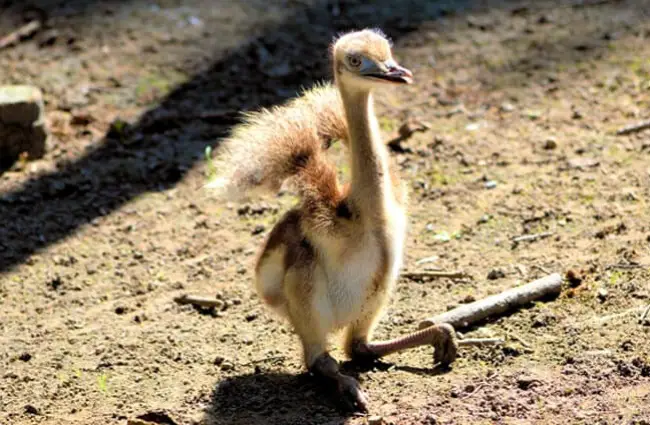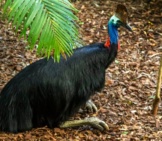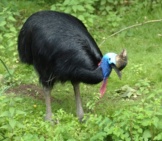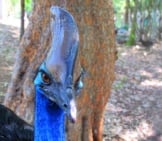The cassowary is a large, flightless bird, native to New Guinea and Australia. There are three different species of cassowaries alive today. These birds are notoriously aggressive, and their kicks can be quite dangerous. Most cassowary attacks occur when the birds are provoked or fed. Read on to learn about the cassowary.
Description of the Cassowary
Cassowaries are quite large. Female cassowaries can weigh as much as 130 lbs., and can be well over 6 ft. tall! They have loose, long black feathers across their bodies. Their long legs are featherless, as are their heads and necks.
The skin on this bird’s head and neck are bright blue, and some species have red or orange waddles hanging from their chins. Their skull is equipped with a tall helmet-like structure known as a “casque.” It is made of keratin, and covered in skin. This casque can grow up to 7 in. tall, and its function is highly debated.
Interesting Facts About the Cassowary
These extraordinary-looking and shy birds have a number of unique characteristics that differentiate them from other flightless birds. They are truly one of a kind animals, and are actually very misunderstood.
- Cassowary Claws – Cassowaries have very large feet, each having three long toes, each of which has a long claw to protect the bird. The claw on the second toe can be up to five inches long! When cassowaries attack a potential predator, they use their powerful legs and long claws to protect themselves.
- Cassowary Attacks – Despite their reputation of aggression, cassowary attacks are largely due to human error. A study of these attacks showed that 75% of the birds had been fed by humans, and only 15% of the attacks involved kicks. There is only one documented instance of a cassowary killing a human. In April of 1926, two teenaged brothers attacked a cassowary on their property with clubs. One of the boys fell, and the bird kicked him in the neck. It is easy to see that humans instigate many attacks from cassowaries.
- When You Can’t Fly… – Instead of fighting, cassowaries prefer to retreat and hide in the face of danger. Instead of flying as a defense mechanism, cassowaries are equipped with powerful legs built for running at high speeds. They can dash through dense forests at speeds up to 31 mph!
- Bid Bird – Another adaptation to make up for lack of flight is immense size. Cassowaries are incredibly large birds. They are actually the second-heaviest bird in the world, behind ostriches. These birds can tip the scales at up to 130 lbs., and they can stand well over 6 ft. tall! Not many predators want to take on an adversary that large.
Habitat of the Cassowary
Cassowaries preferred habitat is the dense rainforests of New Guinea and northern Australia. They use these humid forests to hide from potential predators and search for food in safety. They have been known to inhabit swamp forests, palm scrub, grassland, and savanna as well, though infrequently.
Distribution of the Cassowary
The cassowary’s range is restricted to northeastern Australia, New Guinea, and the surrounding islands. Scientists are unsure if cassowaries were originally found on some of these islands, or if the birds arrived there through trade with other native tribes.
Diet of the Cassowary
Cassowaries love fruit, and most are predominantly frugivorous. The vast majority of their diet consists of fruit, but when fruit is scarce they will also eat flowers, snails, insects, mushrooms, frogs, birds, fish, rats, and mice. They have also been known to scavenge on carrion when food is particularly scarce.
These birds are known to eat well over 26 different species of fruit. Some plant species can only reproduce if the seeds have been through the digestive system of the cassowary!
Cassowary and Human Interaction
Cassowaries are notorious for being aggressive birds, and there have been multiple attacks on humans. As discussed above, these attacks are generally due to human error and feeding the birds.
The most dangerous aspect of cassowary attacks is kicks by their powerful legs. Their feet are equipped with long claws that can injure or kill a predator. Thankfully, in human attacks, only 15% of the birds kicked or attempted to kick.
Domestication
In some societies in New Guinea, cassowaries are raised from chicks for food and as ceremonial gifts. This practice has created semi-tame individuals in those animals that have been selectively bred for generations. This makes cassowaries one of the only Australasian animals to be partly domesticated prior to European settlers arriving.
Does the Cassowary Make a Good Pet
Cassowaries are large birds that can be aggressive and attack humans. In most places is it illegal to own a cassowary as a pet, and it is not advisable.
Cassowary Care
In zoos, cassowaries are provided with plenty of space to roam and lots of vegetation to provide a dense cover. These birds are quite shy, and like to have plenty of hiding spaces. In zoos these birds are fed a variety of fruits and vegetables, as well as the occasional rat or mouse.
Behavior of the Cassowary
Cassowaries are mostly solitary birds, but they will congregate around a plentiful food source, like a tree ripe with fruit. They are believed to be crepuscular, which means they are most active at sunrise and sunset.
Unfortunately, scientists know very little about cassowary behavior because of these birds’ home range. Anytime a human approaches, cassowaries simply disappear into the dense rainforest. This makes it very difficult to study them in the wild.
Reproduction of the Cassowary
Cassowaries breed in May and June, and during this time, male cassowaries build nests and defend a territory from other males. Females pick the males with the best territory, and lay eggs in their nests. She will lay anywhere from 3 – 8 green eggs in the leaf nest, and then move on to the next territory.
The male cassowary defends the nest and incubates the eggs. It takes 50 – 52 days for the eggs to hatch, during which time the male will add or remove leaf litter to keep the temperature steady. After the chicks hatch he will defend them ferociously, up until the day they leave the nest at 9 months old.











![Red Angus Closeup of a beautiful Red Angus cowPhoto by: U.S. Department of Agriculture [pubic domain]https://creativecommons.org/licenses/by/2.0/](https://animals.net/wp-content/uploads/2020/03/Red-Angus-4-238x178.jpg)












![Red Angus Closeup of a beautiful Red Angus cowPhoto by: U.S. Department of Agriculture [pubic domain]https://creativecommons.org/licenses/by/2.0/](https://animals.net/wp-content/uploads/2020/03/Red-Angus-4-100x75.jpg)

